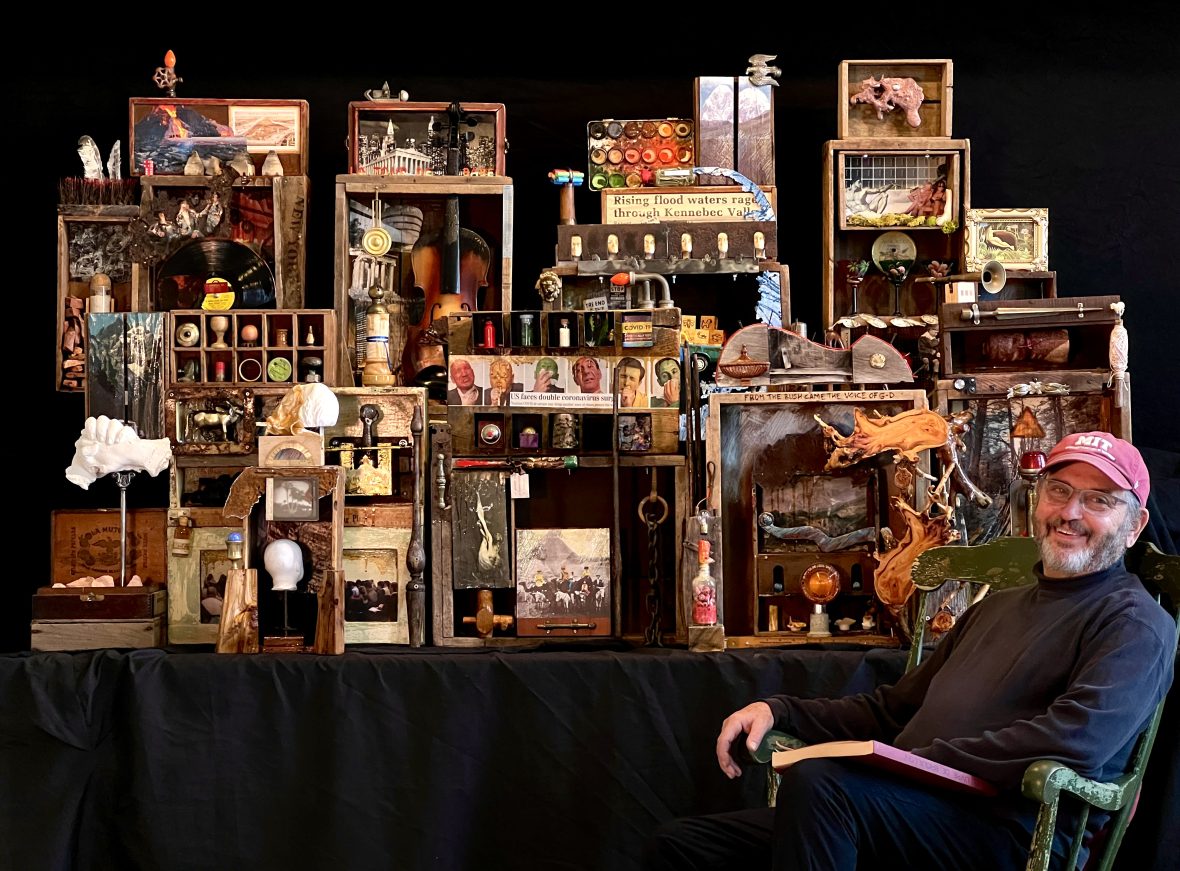
The Art of Assemblage: Myth, Mystery and Spirituality centers the artistic practice of assemblage – artworks made of found objects – and questions of spirituality. The four contemporary Maine artists included, Abigail Read, David Matson, Sally Wagley, and Robert Katz, employ a diversity of approaches to assemblage, and represent a variety of spiritual traditions. Organized by artist Robert Katz, a UMA Art professor who is retiring after more than 40 years of dedicated service to UMA’s community, the exhibition is also valedictory. The exhibition marks Professor Katz’s impact on the Arts at UMA with characteristic generosity, contextualizing and highlighting the work of other artists with whom his work is in conversation in lieu of a solo retrospective.
The Art of Assemblage: Myth, Mystery and Spirituality includes artists whose use of assemblage turns the bricolage of found and re-contextualized objects toward spiritual considerations. The exhibition is supported by an original essay by Dr. Aaron Rosen, Professor of Religion & Visual Culture and Director of the Henry Luce III Center for the Arts & Religion at Wesley Theological Seminary. In his essay, Dr. Rosen wrote, “The artists come from a range of religious traditions, from Katz’s Jewish upbringing in Brooklyn and continued study of Jewish sacred texts to David Matson’s vocation as an Episcopal parish priest. Despite such different spiritual journeys, the artists bring a similarly non-dogmatic, playful spirit to their works, sparking numerous interreligious parallels and dialogues along the way.”
The Art of Assemblage: Myth, Mystery and Spirituality also marks the culmination of a consequential teaching career for exhibition organizer Robert Katz, who began his work as an Art professor at UMA in 1981. An accomplished artist who has exhibited his work extensively nationally and internationally, and whose works are held in the collections of the Maine Holocaust and Human Rights Center, and List Visual Arts Center at MIT in Cambridge, Massachusetts where it is on permanent display, Katz powerfully shaped the arts at UMA. He was the first director of the University art gallery, which he directed for a total of sixteen years; he inaugurated the University’s art collection, and taught sought-after courses in metal sculpture and 3-D design. Former students Arielle Cousens and Ben Stoodley wrote, “Looking back now, Bob’s willingness to help guide students on their own unique journey is something you can’t teach, but must inspire within students. Bob inspired us to follow our artistic dreams, to support others, to help others, to be a part of the community. Bob has kept the Arts alive for us and for UMA as well.” Professor Peter Precourt, a colleague of Professor Katz for sixteen years, explained Katz’s impact, “While being both an internationally recognized artist whose work is in some of the finest collections in the world and an international scholar who has spoken at some of the oldest institutions in the English speaking world, it is Bob’s love of bringing art, artists and community together that is his greatest gift to UMA. From his early work as UMA’s first gallery director, to the public sculpture that he has brought to campus, to the landscape architecture at the pond where we eat and talk, to his permanent installation at the HHRC, Bob’s gentle artistic interventions have transformed UMA from a place where students take classes into a university campus.”
In organizing The Art of Assemblage: Myth, Mystery and Spirituality, Professor Katz has brought together his legacies as an artist, educator, and community member, gathering people together in consideration of the ways the stuff of the world can point to new dimensions of the spiritual. The exhibition marks a culminating moment of art, community, and conversation built on Professor Katz’s enduring legacy.
The Charles Danforth Gallery at the University of Maine at Augusta is located in Jewett Hall, and is open Monday through Friday from 9 a.m. to 4 p.m. ET. All are invited to a Zoom panel discussion February 22 at 6 p.m. ET.
Robert Katz
Robert Katz’s sculptural installations often utilize a rich visual language to explore issues about personal identity and remembrance. His art reflects themes of exile, redemption and moral imperative.
His sculptures have been exhibited at the Jiangsu Chinese Art Academy in Nanjing, China; the Derfner Judaica Museum in Riverdale, New York; The Charter Oak Cultural Center, Connecticut, and his mixed media installation, The Five Books of Moses was recently installed at the List Visual Arts Center on the campus of the Massachusetts Institute of Technology. He is the designer of numerous Holocaust Memorials.
Katz has been the resident artist at the Seeds of Peace International Camp, the Minneapolis College of Art and Design, and the Academy of Fine Arts in Krakow, Poland. He has also been a guest speaker at international conferences in Poland and Israel. In addition, he was a guest artist at Oxford University and the Interfaith Programme at Cambridge University, England as well as the World Affairs Council, the Nexus Centre for the Humanities in Newfoundland and the Canadian Immigration Museum in Halifax.
Most recently, he led a team of designers to create The Welcome Table Project that commemorates the life and legacy of Dr. Martin Luther King Jr. This landscaped memorial has been funded by the Glickman-Lauder Foundation and will be constructed on the campus of the University of Maine at Augusta. He is also the recipient of the JAW Art Fellowship from the Amen Institute for which he created The Biblical Tableaux.
Katz grew up in Brooklyn New York and he earned his undergraduate degree from New York University. In 1973 he moved to Montana where he established a studio practice and where he received a MFA from the University of Montana. For the past forty years he has lived in central Maine. He is a Professor of Art at the University of Maine at Augusta and serves on the Board of Directors of the Holocaust and Human Rights Center of Maine.

